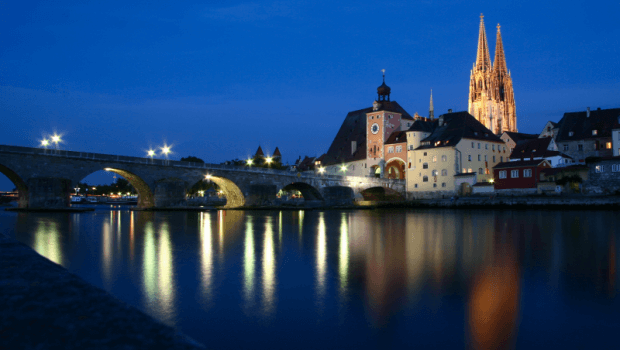
Stone Bridge Regensburg: A city that even war could not destroy
The old stone bridge was built in the 12th century, 1146 to be exact. For over 800 years, this medieval construction, which measures upto 310 meters, was the only bridge of the city. The bridge is solely for pedestrians, and no vehicle is allowed on the bridge that has almost become the city’s emblem. The bridge originally replaced a wooden bridge, but legend has something much more interesting to say.
In the foreground of Danube, stands a monumental dedication to St. Peter, The Regensburg Cathedral. Legend has it that the builder of this Cathedral and the builder of the bridge, who were working on their respective projects at the same time decided to strike a bet.
Whoever finished their task first would be the winner. However, when the cathedral started taking shape much faster than the bridge, the builder of the bridge asked the Devil for his help, in exchange for a tricky price that the builder soon found loopholes in. The Devil put it this way; He would take with him the first eight feet that walked or the three souls that crossed the bridge. Needless to say, the Devil did his job. The bridge was completed long before the cathedral, and the builder of the bridge won the bet against his rival.
However, the first three souls that crossed the bridge, or the first eight feet to walk over it were those of a rooster, a dog, and a hen, a clever strategy adopted by the Builder. The bridge as we see it today is bent, because (it is believed) the Devil attempted to destroy it in his rage, but failed.
Location
The Bridge acts as a link between Old Town and Stadtamhof, its exact address being Wiebe-Lamm-Gasse, 93047, Regensburg.
Weather
The atmosphere is generally humid and is more on the continental side. It is slightly warmer here than it is in the rest of Germany and the average precipitation is higher too. Sun shines brighter and longer here, July being the warmest month and the coldest being January.
History
The original bridge Charlemagne was a 100-meter long wooden bridge that was soon replaced by the stone bridge that (unlike the wooden bridge) can handle traffic and has the power to live through droughts. The stone bridge is a work of some 11 years from 1135-46. It was utilized by France’s Louis VII as a way to cross the Danube to proceed towards the Second Crusade. Later, several similar bridges modeled after this bridge were built across Europe, like the London Bridge (Thames), Augustus Bridge (Dresden), The Pont d’ Avignon (Rhone) and so on. The bridge, being the only way to cross the river in the midst of Ulm and Vienna remained a vital trade passage until the Nibelungen Bridge was built.
Initially, the bridge was taken care of with the help of tolls and had a separate administration body. The bridge has sixteen arches, making it an arch bridge. Its initial length was 336 meters, but the construction of its first pier shortened it to 308.7 meters. The Stadtamhof bridge end is higher than the Old Town end by a half meter, caused by the river’s course at the time of construction. The summer of 1135 was surprisingly hot, which made the construction of the bridge extremely convenient due to the low water levels.
In 1633, the Bavarians, in the Thirty Years’ War burnt down the watermills built towards the South of the bridge that utilized the currents created by the bridge. The few that were rebuilt in 1655 were wrecked due to an ice dam. For a few years, another watermill was constructed near the Salt store. When the Swedish attacked the city during the Thirty Years’ War, they caused the destruction of the fourth bridge span. The gap that was created was then temporarily filled by a drawbridge made of wood and was repaired only in the 1790-91 when the flaw started to weaken the bridge visibly.
One out of the bridge’s three towers survives today, which is the South Tower, also known as the Old City’s Gate Tower. The first South tower was a 1300 construction standing beside St. Margret’s Chapel. When the chapel got converted into a prison for debtors in the 16th century, the tower too became known as the Debt Tower. The middle tower (built around 1200) and the South tower were destroyed in the Thirty Years’ War. They were put on fire by the Swedish invaders. 1648 saw the reconstruction of both of these towers, and this time, the clock that is engraved in it even today was added to the South tower. The Ice Dam destroyed the middle tower in 1748. The North tower is estimated to be constructed in the latter half of the 12th century to compliment the bridge but was destroyed when the city was taken over from the Austrians by the Bavarians and the French. This tower, also known as the Black Tower, was replaced by a bazaar in 1824-25.
The bridge today has various sculptures that have fascinating stories behind them, and must be visited in order to be understood and absorbed.
The City
Regensburg, with its 1404000 inhabitants is Eastern Bavaria’s cultural, political and economic center. It ranks high among the most favored travel destinations and boasts of a perpetually growing economy. Regensburg is one of the few parts of Germany that were lucky enough to be undamaged by the devastating Second World War leading to it still possessing its medieval city center. Perhaps that is why, in 2006, UNESCO declared the old city a World Heritage Site.
It is fondly known as the “Northernmost city of Italy” due to its narrow alleys, outdoor cafes during the summer, welcoming and warm streets and the sheer number of towers and medieval merchant houses. You can never be short of variety here when it comes to food. Do pay a visit to Wurstkuche, 500-year-old fast food joint, the oldest of its kind in the world. ‘Domspatzen’ is a choir that sings almost every Sunday in the Regensburg cathedral and people come from far and wide for them. Take home with you a few pints of beer from breweries that are centuries old, making it the city that has the highest concentration of beers.
Traveling the City
An advanced and comprehensible bus network runs throughout the city until midnight and buses generally arrive at an interval of 10 minutes. ‘Altstadbus’ takes its passengers to explore the area around City Centre, up to the train station. The City Centre is tough to drive a car into but is pedestrian friendly.
Why Visit
Globally, Regensburg is counted among the top 30 travel destinations in Germany. The bridge, when it was built, had three towers of which only one survives, that is the Bridge Tower Museum that houses important documents and articrafts concerning the construction of the bridge. The tower clock from the 17th century is also a part of this historic monument. You will also find here a 12thcentury Sausage Kitchen and Salt Warehouse of 1620, often used for community events.
The city offers many fantastic guided tours, Stadtmaus being among the best. It is believed that there are so many chapels in the city, that you can always hear at least one Church bell ringing.
Major Attractions
- Regensburg Cathedral: An epitome of Gothic architecture, this 13th-century cathedral with its stained glass from the 14th-century displays textile and gold of almost nine centuries. From 11th to 20th centuries, among other jaw-dropping
- Schottenkirche: Irish monks, in 1150, built this monastery, now also known as Scots Monastery housed various Scottish missionaries and monks from 1560 to 1860.
- The old Town Hall and Cornmarket: This is the most ancient part and the essence of the UNESCO world heritage Site. It has many parts that will leave their impression in your heart, and its Reichssaal is where the First German Parliament met.
- Blasius: Built in the 13th century, this Gothic church is among the oldest of its kind and includes various major attractions, like the teaching classroom of the scholar St. Albertus Magnus and his desk from the 15th century. There are also various beautiful tombs and murals to be visited.
- Emmeram’s: This spectacular Church dates back to the 7thcentury when it replaced a Roman building. Since then, through the centuries, various additions have been made to the building, like in 1733, when a baroque interior was added to it.
- Regensburg Museum of Danube Shipping: A detailed display of the progression of the shipping industry in Danube and artifacts related to the lives of sailors.
- Art Forum East German Gallery: Numerous drawings, paintings, sculptures, consisting majorly of modern art belonging to artists from many regions of Europe that are culturally dedicated to Germany are displayed here.
- Herzogspark: This 1293 public park is not only an ideal place to spend a few hours in, but it also includes Prebrunntum (a tower that was constructed along with the garden), a botanical garden among many other fascinating displays.
- Wurttembergisches: Step back in time with the Natural History Museum of Eastern Bavaria, which is located
What Else is Around
- Walhalla
- Beferiungshalle
- Weltenburg Abbey
- Bavarian Forest
- Munich
- Passau
- Landshut
- Straubing
With so many places to explore and see around, Stone Bridge Regensburg and the nearby tourist hotspots are the perfect places to visit during your next visit to Germany. Go ahead and plan a vacation to this place and enjoy exploring the beautiful places – you would love it!
